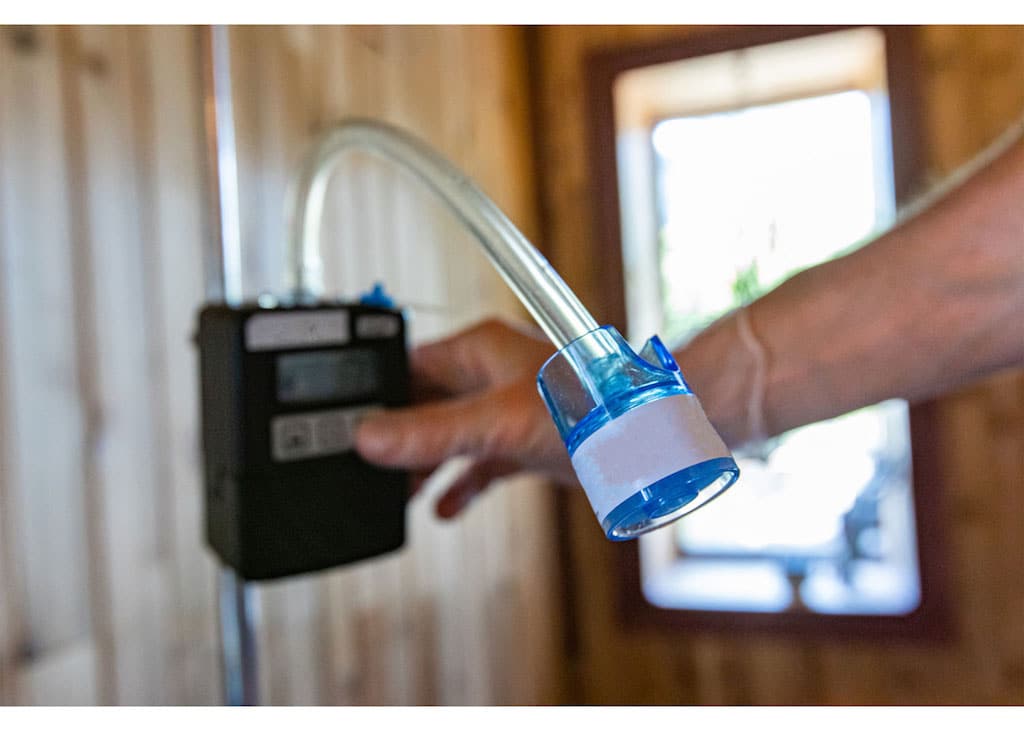No products in the cart.
Mold spores exist in every home. That’s right! Every single home. They can float right in through the front door. But without the proper environment to hunker down and grow, they don’t pose a problem. When these spores begin to multiply is when trouble hits. That means understanding mold presence in the home is critical for maintaining a healthy living environment. It would seem like there would be multiple mold regulations for homes, but unfortunately, that’s not the case. Currently, the EPA says there are no set standards for acceptable mold levels.¹
What they do say is that molds can impact your health once settled into your home and if you do have mold growth, you should clean up the mold quickly and fix the water problem.²
That’s a bit of an oxymoron.
Why are they taking longer for regulations? The main problem most likely is cost. Once the EPA agrees that regulations are needed, it will be a multi-trillion dollar problem to make sure every home is up to code.
In the professional mold community, the majority of us have moved on from the lack of regulations to form the consensus that:
The goal for treatment is to ensure there are no active mold colonies producing contamination inside your home that would create a poor environment for you to live in.
We’ve taken a good look at the science behind mold to better understand how it impacts individuals, and we created methods on how to treat homes. Your health and the health of your family are what’s most important and what should be the focus of treatment. Just because there aren’t regulations now, doesn’t mean we have to wait 20 years for action. We can collectively work to build mold awareness so that everyone understands what to do when they see mold and how to prevent it from occurring.
WHAT IS MOLD?
Molds are a type of fungus that grows in the form of hyphae (think a small branch with a bunch of twigs coming off of it). Over tens of thousands of different species of molds have been discovered so far. They come in a rainbow of colors and fall into three basic categories: allergenic, pathogenic, and toxigenic. Some are immediately toxic to the human body and some produce compounds that can cause negative side effects.³
Being the hardy little organisms they are, all molds need to grow are food (they eat pretty much anything), oxygen, temperature (they basically won’t grow only in temperature extremes), and moisture. Moisture’s the key ingredient for mold happiness. While outdoors are great habitats for molds, homes are even better. We keep them at a controlled temperature and fill them with tons of things molds can eat!

As for reproduction, molds release microscopic spores that can float through the air. Similar to weeds. Think of how quickly dandelion puffs reproduce and spread. The spores are the tiny little seeds the dandelion releases; we just can’t see the spores. That means there could be hundreds of thousands of spores floating around, completely undetected in a home.
The difference between spores and seeds is that spores can land on any surface and stick. Tabletops, couches, clothes, food- you name it. That nifty ability makes remediation especially difficult.⁴
Not to mention, some molds produce microscopic toxins when they feel threatened. These compounds, called mycotoxins, also cause a range of negative health effects and float through the air completely undetected.
Only slightly frightening…
MOLD AND HEALTH: WHY WE NEED MOLD REGULATIONS
The tricky thing about mold exposure is that it cause a range of side effects, depending on the individual. Some people experience heightened sensitivity, which means they start experiencing symptoms faster and can have a more severe reaction.⁵ ⁶
Symptoms range from irritating:
-Brain fog
-Coughing
-Fungal Infections (like Athlete’s Foot)
-Fatigue
-Stuffy Nose
To more severe side-effects:
-Respiratory Issues
-Digestive Issues
-Neurological Problems
-Immunosuppression
Check out my Mold Talks for personal stories from real people who experienced mold exposure and the side effects that go along with it.
When you have a mold problem, these spores and toxins can float around your house by the thousands. And, land on anything that they come in contact with. That means you’re inhaling and touching the spores and toxins all day, every day. It’s a big tax on the body, which is why understanding the scope of the problem is so important and why the lack of regulations is questionable.
TESTING FOR MOLD
If you’re concerned you have mold in your home, those first steps seem daunting. With no mold regulations and an industry backlogged in misinformation, the process to treat your home is unnecessarily murky. But, it doesn’t have to be!

The first step to understanding your potential mold problem is to test your home. You can’t solve the issue without knowing what you’re up against. That means you need a qualified inspector to assess your indoor air quality and provide you a detailed roadmap for your remediation team (if you do have a problem).
When it comes to mold testing, the first and most important step is to compare the outside mold levels to the suspected area. Mold spores exist in every home- it’s just a fact of life. The question though is if the inside of your home has more spores of a particular species than the outside.
If there are 100 spores per cubic meter of aspergillus outside your home versus 100,000 spores inside your home, that clearly shows us that there’s an air quality problem.
Do not let a mold expert tell you otherwise or that “there aren’t mold regulations or standards for acceptable levels of mold.” A disparity like that screams mold problem and needs to be addressed.
A FEW OTHER ASPECTS YOUR INSPECTOR SHOULD LOOK FOR ARE:
- Types of molds present
- Quantities of each mold
- Potential spore presence in the HVAC system
- Presence of mycotoxins (a harmful toxin produced by molds)
- Presence of bacteria
It will take a few hours, but again, that’s a detailed picture of the state of your home. It’s worth it. There could be levels of toxic mold that need to be dealt with immediately or high levels of multiple mold species that could be causing health problems you weren’t even aware of.
Testing also allows you to prioritize which area of your home to tackle first. If your bathroom has 10,000 mold spores but your basement has 100,000, you’re going to want to take care of the bigger problem first. It’s easy to say “remove all mold,” but remediation can be difficult and costly. Mold tests allow you to create bite-sized steps to deal with your mold exposure issue.
After testing, you’ll need to find a remediation team equipped to deal with your mold problem. Check out HomeCleanse’s remediation page for a cheat sheet on how to find the best company for your home.
THE IMPORTANCE OF AWARENESS IN THE ABSENCE OF MOLD REGULATIONS
There’s a lot to consider when it comes to mold in your home. Without regulations or a roadmap to follow, the burden falls on all of our shoulders to build mold awareness. We’ve got to become advocates for our own health and to be an advocate, we have to understand:
1. How mold works
2. How it can affect us
3. How to solve the problem.
That may seem like a lot to ask, but together we can tackle the issue and navigate through the mass of misinformation out there.
While research continues to know exactly how mold affects our health, at the end of the day we know it causes an effect. Those symptoms could be mild, or they could be life-threatening. Because of that, understanding, treating, and preventing mold in our homes should be a top priority for us all.
Your health and the health of your family (and pets) are worth it! Regulations or not.
Still Have Questions?
A member of our team is here to help! Click on “Get Started ➤” below to book a consultation with a member of the HOMECLEANSE team. We have a few quick questions that will help us put together a roadmap to solve or prevent all of your mold problems.
Two minutes of your time could lead to better health for you and your family.
- Environmental Protection Agency. (n.d.). Are there Federal regulations or standards regarding mold? EPA. https://www.epa.gov/mold/are-there-federal-regulations-or-standards-regarding-mold.
- Environmental Protection Agency. (n.d.). Mold . EPA. https://www.epa.gov/mold.
- Zabka, M., Pavela, R., & Prokinova, E. (2014). Antifungal activity and chemical composition of twenty essential oils against significant indoor and outdoor toxigenic and aeroallergenic fungi. Chemosphere, 112, 443-448.
- Centers for Disease Control and Prevention. (2020, August 11). Basic facts about mold and dampness. Centers for Disease Control and Prevention. https://www.cdc.gov/mold/faqs.htm.
- Bush RK, Portnoy JM, Saxon A, Terr AI, Wood RA. The medical effects of mold exposure. J Allergy Clin Immunol. 2006 Feb;117(2):326-33. doi: 10.1016/j.jaci.2005.12.001. Erratum in: J Allergy Clin Immunol. 2006 Jun;117(6):1373. Erratum in: J Allergy Clin Immunol. 2014 Nov;134(5):1217. PMID: 16514772.
- Ratnaseelan, A. M., Tsilioni, I., & Theoharides, T. C. (2018). Effects of Mycotoxins on Neuropsychiatric Symptoms and Immune Processes. Clinical therapeutics, 40(6), 903–917. https://doi.org/10.1016/j.clinthera.2018.05.004
